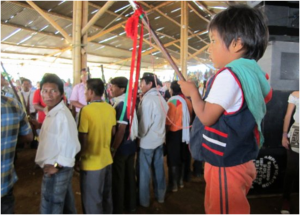 The Nasa people of the Cauca department in south-western Colombia have long tried to assert their neutrality in the Colombian internal armed conflict, between various guerrilla movements, the paramilitaries and drug traffickers, and the national army. Recent conflicts with the FARC and the army indicate the challenges faced by President Juan Manuel Santos’ with his policy of ‘democratic prosperity’, intended to set him apart from Álvaro Uribe’s mantra of ‘democratic security’. LAB’s Francis McDonagh analyses recent events.
The Nasa people of the Cauca department in south-western Colombia have long tried to assert their neutrality in the Colombian internal armed conflict, between various guerrilla movements, the paramilitaries and drug traffickers, and the national army. Recent conflicts with the FARC and the army indicate the challenges faced by President Juan Manuel Santos’ with his policy of ‘democratic prosperity’, intended to set him apart from Álvaro Uribe’s mantra of ‘democratic security’. LAB’s Francis McDonagh analyses recent events.
 Since colonial times the Nasa have defended their independence, and since the beginning of the current Colombian conflict they have been forced to share their mountain territory with the FARC guerrillas, as the region, along with Marquetalia in the south of Tolima, is one of the birthplaces of the FARC. When, as frequently the case, the government in Bogotá was hostile, the guerillas’ proposals were interesting, and young indigenous did join their ranks, but to label them as stooges of the FARC, as conservatives have done, is nonsense. Daniel Samper Pizano sets out the historical background very well in an article in the Santos family newspaper, El Tiempo. Over the last fifteen years, however, the indigenous, especially the Association of the Cabildos of the Northern Cauca, ACIN, have focused on recovering their traditional culture, and their territory. They have also asserted their neutrality in the Colombian armed conflict, and attempted to resist co-option by what they label, without distinction, ‘armed groups’: the national army, the FARC and the paramilitaries.
Since colonial times the Nasa have defended their independence, and since the beginning of the current Colombian conflict they have been forced to share their mountain territory with the FARC guerrillas, as the region, along with Marquetalia in the south of Tolima, is one of the birthplaces of the FARC. When, as frequently the case, the government in Bogotá was hostile, the guerillas’ proposals were interesting, and young indigenous did join their ranks, but to label them as stooges of the FARC, as conservatives have done, is nonsense. Daniel Samper Pizano sets out the historical background very well in an article in the Santos family newspaper, El Tiempo. Over the last fifteen years, however, the indigenous, especially the Association of the Cabildos of the Northern Cauca, ACIN, have focused on recovering their traditional culture, and their territory. They have also asserted their neutrality in the Colombian armed conflict, and attempted to resist co-option by what they label, without distinction, ‘armed groups’: the national army, the FARC and the paramilitaries.
This policy achieved a striking success on 17 July when the ACIN captured an army communications centre on a hill-top called Berlín. It was more of a symbolic than strategic victory, since the army recaptured it the next day, but an eloquent expression of their frustration at the lack of government support for their model of indigenous development. There is a fascinating video on the ACIN website that shows the indigenous remonstrating with the army about the killing of an indigenous man: http://www.nasaacin.org/. The website demonstrates what a sophisticated communications operation the ACIN runs.
The conflicts with the army brought two visits in August by President Santos to the Cauca, where he met the indigenous and publicly recognised that they were not linked to the guerrillas, but refused their demand that the ACIN’s indigenous guard, armed only with staves, should replace the army in repelling the FARC.
The ACIN have already been exerting pressure on the guerrillas, especiallyafter they killed an 81-year old religious leader, Lizandro Tenorio Tróchez. The indigenous seized four FARC fighters and subjected them to a traditional trial.
For the moment, dialogue has been established between the indigenous of the Cauca and Santos’ government. But it is reported that the government is planning a massive offensive against the FARC in the mountains of the Cauca, which will mean continued suffering for the indigenous communities. Perhaps more fundamentally, it is not clear that President Santos’ policy of ‘democratic prosperity’, which is based on more intense exploitation of natural resources, is compatible with the indigenous’ aspirations to sustainable development. The CRIC, the Cauca Indigenous Regional Council, is protesting against the government’s plans for mining in the region.

